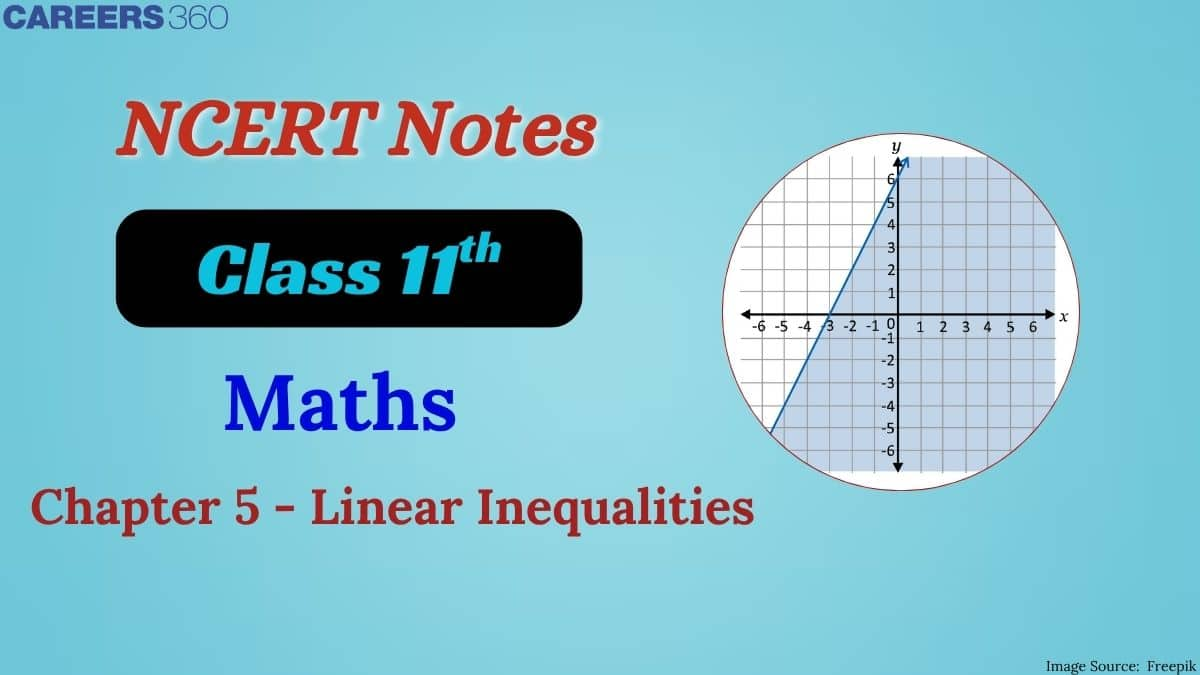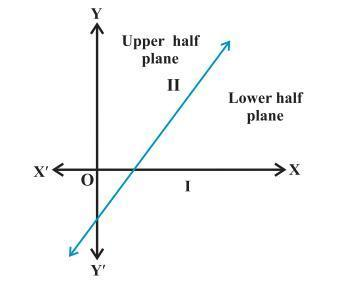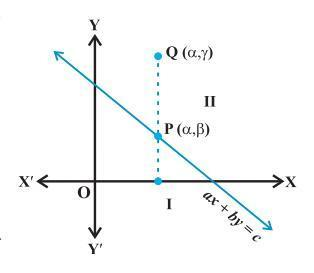Linear Inequalities Class 11th Notes - Free NCERT Class 11 Maths Chapter 6 notes - Download PDF
Linear Inequalities represent the situation where some constraints are applied. For example, if we say the sum of x and y cannot be greater than 11, then it is written as $x+y \leq 11$. Such types of equations are considered linear inequalities, and these NCERT Class 11 Maths Chapter 5 Notes help you to understand the concepts of linear inequalities and how to solve them. In our daily life, we encounter different scenarios from managing financial budgets to optimisation. Linear Inequalities play a very important role in decision-making when encountering such real-life situations. As per the latest NCERT syllabus for class 11, the chapter Linear Inequalities contains the concepts of inequalities in one variable, inequalities in two variables, and how to solve them using graphs or linear representation.
This Story also Contains
- Class 11 Linear Inequalities Notes PDF – Download Free Study Material
- Linear Inequalities Class 11 Notes
- How to Use the Linear Inequalities Class 11 Notes Effectively?
- Linear Inequalities Class 11 Notes: Previous Year Question and Answer
- NCERT Class 11 Maths Notes – Chapter-Wise Links

These NCERT notes for Class 11 Maths offer well-structured study material to prepare for linear inequalities. It will help the students with quick revision. These NCERT notes are trustworthy and reliable, as they are created by subject matter experts at Careers360, making them an essential resource for exam preparation. Find everything in one place – NCERT Books, Solutions, Syllabus, and Exemplar Problems with Solutions – in this NCERT article.
Also, read,
Class 11 Linear Inequalities Notes PDF – Download Free Study Material
Students who wish to access these NCERT Class 11 Maths Chapter 5 Notes can click on the link below to download the entire notes in PDF.
Linear Inequalities Class 11 Notes
Careers360 experts have curated these NCERT Class 11 Maths Chapter 5 Notes to help students revise quickly and confidently.
Linear Inequalities
A linear inequality is defined as an expression where any two values are compared by the inequality symbol, such as $<, >, ≤, ≥$
Let us take an example.
Ram has Rs. 120 and wants to buy some bats and balls. The cost of one register is Rs. 40, and that of a pen is Rs. 20. In this case, if $x$ denotes the number of bats and $y$, the number of balls that Ram buys, then the total amount spent by her is Rs. $(40x + 20y)$, and we have:
$40x + 20y ≤ 120$
A statement involving the symbols ' $>$ ', ' $<$ ', ' $\geq$ ', ' $\leq$ ' is called an inequality. For example $5>3, x \leq 4, x+y \geq 9$.
(i) Inequalities that do not involve variables are called numerical inequalities. For example, $3< 8,5\geq2$.
(ii) Inequalities that involve variables are called literal inequalities. For example, $x>3, y \leq 5, x-y \geq 0$.
(iii) An inequality may contain more than one variable, and it can be linear, quadratic, cubic, etc. For example, $3 x-2<0$ is a linear inequality in one variable, $2 x+3 y \geq 4$ is a linear inequality in two variables, and $x^2+3 x+2<0$ is a quadratic inequality in one variable.
(iv) Inequalities involving the symbol ' $>$ ' or ' $<$ ' are called strict inequalities. For example, $3 x-y>5, x<3$.
(v) Inequalities involving the symbol ' $\geq$ ' or ' $\leq$ ' are called slack inequalities. For example, $3 x-y \geq 5, x \leq 5$.
Solution of an inequality
(i) The value(s) of the variable(s) which make the inequality a true statement are called its solutions. The set of all solutions of an inequality is called the solution set of the inequality.
For example, $x-1 \geq 0$ has an infinite number of solutions, as all real values greater than or equal to one make it a true statement.
The inequality $x^2+1<0$ has no solution in $\mathrm{R}$ as no real value of $x$ makes it a true statement.
To solve an inequality, we can:
(i) Add (or subtract) the same quantity to (from) both sides without changing the sign of the inequality.
(ii) Multiply (or divide) both sides by the same positive quantity without changing the sign of the inequality. However, if both sides of inequality are multiplied (or divided) by the same negative quantity, the sign of inequality is reversed, i.e., ' $>$ ' changes into ' $<$ ' and vice versa.
Representation of the solution of a linear inequality in one variable on a number line
To represent the solution of a linear inequality in one variable on a number line, we use the following conventions:
(i) If the inequality involves ' $\geq$ ' or ' $\leq$ ', we draw a filled circle $(\bullet)$ on the number line to indicate that the number corresponding to the filled circle is included in the solution set.
(ii) If the inequality involves ' $>$ ' or ' $<$ ', we draw an open circle (O) on the number line to indicate that the number corresponding to the open circle is excluded from the solution set.
Graphical representation of the solution of a linear inequality
(a) To represent the solution of a linear inequality in one or two variables graphically in a plane, we proceed as follows:
(i) If the inequality involves ' $\geq$ ' or ' $\leq$ ', we draw the graph of the line as a thick line to indicate that the points on this line are included in the solution set.
(ii) If the inequality involves ' $>$ ' or ' $<$ ', we draw the graph of the line as a dotted line to indicate that the points on the line are excluded from the solution set.
(b) Solution of a linear inequality in one variable can be represented on the number line as well as in the plane, but the solution of a linear inequality in two variables of the type: $a x+b y>c, a x+b y \geq c, a x+b y<c$
or $a x+b y \leq c(a \neq 0, b \neq 0)$ can be represented in the plane only.
(c) Two or more inequalities taken together comprise a system of inequalities, and the solutions of the system of inequalities are the solutions common to all the inequalities comprising the system.
Algebraic Solutions Of Linear Inequalities In One Variable And Their Graphical Representation
Equal numbers may be subtracted from or added to both sides of an inequality without affecting the inequality sign.
Example:
Solve 5x – 3 < 3x +1
when
(i) x is an integer
(ii) x is a real number.
Solution:
We have,
5x –3 < 3x + 1
⇒ 5x –3 + 3 < 3x +1 + 3 (Rule 1)
⇒ 5x < 3x +4
⇒ 5x – 3x < 3x + 4 – 3x (Rule 1)
⇒ 2x < 4 or x < 2 (Rule 2)
When x is an integer, the solutions of the given inequality are:
– 4, – 3, – 2, – 1, 0, 1
When x is a real number, the solutions of the inequality are given by x < 2.
i.e., all real numbers x, which are less than 2.
Therefore, the solution set of the inequality is x ∈ (–∞, 2).
Graphical Solution of Linear Inequalities in Two Variables
We know that a line divides the Cartesian plane into two parts known as half-planes.

-
The region consisting of all the solutions of an inequality is called the solution region.
-
If inequality is of the type ax + by ≥ c or ax + by ≤ c, then the points on the line ax + by = c, are also included in the solution region. So draw a dark line in the solution region.
-
If inequality is of the form ax + by > c or ax + by < c, then the points on the line ax + by = c, are not to be included in the solution region. So draw a broken or dotted line in the solution region.

How to Use the Linear Inequalities Class 11 Notes Effectively?
Linear Inequalities is an important chapter in Class 11 because it teaches you how to compare quantities and find possible values that satisfy a condition. These concepts are simple if you learn them thoroughly with examples. Using your Class 11 Maths Chapter 5 notes properly can make this chapter much easier. Here are some more points on how these notes are important.
- Read these topics in order: Inequalities, algebraic solutions, and their graphs to understand each idea before moving to the next.
- Try solving small inequalities while studying and draw the number line graphs to remember the steps clearly.
- Connect what you learn from the NCERT Class 11 Maths chapter 5 notes to higher classes, because inequalities are used in linear programming and other advanced topics in Class 12.
- Keep checking the NCERT Class 11 Maths chapter 5 notes and practice a few simple questions after each topic to see if you fully understand it.
Linear Inequalities Class 11 Notes: Previous Year Question and Answer
Given below are selected previous year question answers for NCERT Class 11 Maths Chapter 5 Linear Inequalities, collected from various examinations.
Question 1:
Solve for x, the inequalities in $\left | x -1 \right |\leq 5,\left | x \right |\geq 2$
Solution:
$\left | x-1 \right |\leq 5........(given)$
(i) Now, there will be two cases –
$x-1 \leq 5,$
Adding 1 on both sides, we get,
$x \leq 6$
(ii) $-\left (x-1 \right ) \leq 5$
i.e., $-x+1 \leq 5$
Subtract 1 from both sides, and we will get,
$-x \leq 4$ i.e $x \geq -4$
Now, from (i) & (ii), we get,
$-4 \leq x\leq 6.........(a)$
& $\left | x \right |\geq 2$'
Thus, $x \geq 2$ & $-x \geq 2$
Thus $x \leq -2$
i.e $x \epsilon(-4,-2] \cup[2,6]$
Question 2:
Solution:
Given: Revenue, R(x) = 43x
Cost, C(x) = 26,000 + 30x,
Where ‘x’ is the no. of cassettes.
Requirement: profit > 0
We know that,
Profit = revenue – cost
= 43x – 26000 – 30x > 0
= 13x – 26000 > 0
= 13x > 26000
= x > 2000
Therefore, 2000 more cassettes should be sold by the company to realise the profit.
Question 3:
Solution:
Let us assume that the length of the shortest side of the triangle is ‘x’ cm
Thus, length of the largest side = 2x …. (given)
& length of the third side = (x + 2) cm …. (given)
Now, we know that,
The perimeter of a triangle = the sum of all three sides
= x + 2x + x + 2
= 4x + 2 cm
Now, it is given that the perimeter of the triangle is more than 166 cm.
Thus, $4x+2\geq 166$
$4x\geq 164$
Thus, $x\geq 41$
Therefore, the minimum length of the shortest side should be = 41 cm.
NCERT Class 11 Maths Notes – Chapter-Wise Links
We at Careers360 compiled all the NCERT class 11 Maths notes in one place for easy student reference. The following links will allow you to access them.
Subject-Wise NCERT Exemplar Solutions
After finishing the textbook exercises, students can use the following links to check the NCERT exemplar solutions for a better understanding of the concepts.
- NCERT Exemplar Class 11 Solutions
- NCERT Exemplar Class 11 Maths
- NCERT Exemplar Class 11 Physics
- NCERT Exemplar Class 11 Chemistry
- NCERT Exemplar Class 11 Biology
Subject-Wise NCERT Solutions
Students can go through these systematically arranged, subject-wise solutions for Class 11.
- NCERT Solutions for Class 11 Mathematics
- NCERT Solutions for Class 11 Chemistry
- NCERT Solutions for Class 11 Physics
- NCERT Solutions for Class 11 Biology
NCERT syllabus and NCERT books
Before the start of a new academic year, students should refer to the latest syllabus to determine the chapters they’ll be studying. Below are the updated syllabus links, along with some recommended reference books.
Frequently Asked Questions (FAQs)
A Linear Inequality is an expression that shows the relationship between two algebraic values using inequality symbols like <, >, ≤, or ≥ instead of an equality sign (=).
A Linear Equation shows equality between two expressions, while a Linear Inequality represents a comparison using inequality symbols.
Graphically, inequalities are represented by shading the region that satisfies the condition, depending on the inequality symbol used.
Many educational platforms, such as Careers360, offer free downloadable PDFs of NCERT Linear Inequalities Notes Class 11. Students can find the free downloadable PDF in this article itself.
Yes, Linear Inequalities generally represent a range of values (an interval) that satisfy the condition rather than a single solution.
Courses After 12th
Applications for Admissions are open.
As per latest syllabus. Physics formulas, equations, & laws of class 11 & 12th chapters
JEE Main Important Chemistry formulas
Get nowAs per latest syllabus. Chemistry formulas, equations, & laws of class 11 & 12th chapters
JEE Main high scoring chapters and topics
Get nowAs per latest 2024 syllabus. Study 40% syllabus and score upto 100% marks in JEE
JEE Main Important Mathematics Formulas
Get nowAs per latest syllabus. Maths formulas, equations, & theorems of class 11 & 12th chapters
